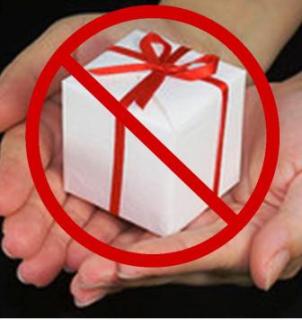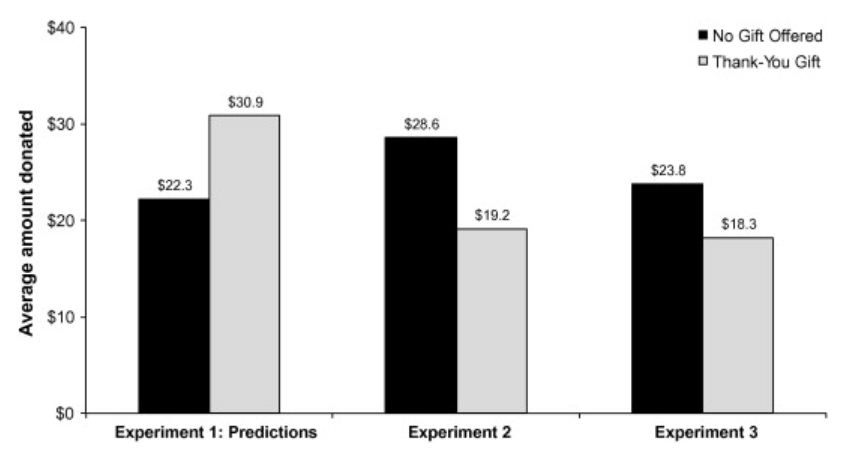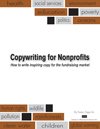 A number of charities try to encourage donations by offering a reward – a thank you gift.
A number of charities try to encourage donations by offering a reward – a thank you gift.
Examples include National Public Radio (NPR), Public Broadcasting System (national, regional and local PBS television stations), many environmental groups (tote bags, stuffed animal toys, etc.), and more.
Problem is that this method of rewarding donors may actually REDUCE the size of the average gift!
An article in Forbes by Roger Dooley brought this to my attention. Dooley cites a paper in the Journal of Economic Psychology, describing the results summarized in the graph below.
.

Average gift amount in #2 and #3 less than what was predicted (via R.Dooley and Forbes)
.
Researchers “…found that the most likely reason for the negative effect on contributions was ‘crowding out.’ In essence, the prospect of receiving a gift activated a feeling of selfishness which, in turn, reduced altruism and hence cut the average donation.”
What do you do? Should you eliminate all thank you gift offers?
NO!
First step is to test extensively any offer you make. See what works best for YOUR nonprofit.
Second, as Dooley points out in his article there are variations on this approach which not only reduce the negative impact of the thank you gift . . . but these alternate approaches may even increase donations.
• Reframe the Context. Don’t simply offer the gift as a way of showing your gratitude for the donation. Instead show donors how the thank you gift also advances the charity’s goals: Help us show people our good work by using this gift in public.
For example: In your copy and scripts, explain and demonstrate to donors how using the tote bag with your logo printed on the side helps raise awareness.
For example: Have a really cool, fun or clever thank you gift? Something people brag about and show off? The article has an example of a “Car Talk” mug and a sample script like this, ““When you put this Car Talk mug on your desk, your co-workers will be so jealous they’ll want to support our station too! So, help us reach the people around you by donating at least $75, and then put your mug where everyone will see it!”
• Send a Social Signal. The study is talking about donor psychology and the act of giving: altruistic behavior is a way of signaling “fitness” to others, and hence public recognition of donations is often desirable. This concept of recognizing donors can be done at ANY level of giving, although we see it most often with mid-level and major donors.
For example: Recognize donors on your website, annual reports, an invitation to an exclusive dinner or lecture, membership in an elite group, etc.
• Surprise the Donor. Don’t tell donors that they’ll receive a gift. Surprise them. Although the study did not address this scenario, as Dooley points out it may be worth testing. This approach eliminates the “crowding out” effect which occurs when the donor is thinking about the thank you gift at the same time as the donation.
• Advance Gifts (freemiums). This approach brings the infamous psychological principle of “reciprocity” into play. Donors feel slightly obligated to give because you’ve sent them these address labels, note pads, holiday cards, etc. Again, test this thoroughly for your nonprofit. And if you’ve never used freemiums, research the pros and cons before implementing this strategy. It is a major business decision.
Dooley shared another article he wrote based on an earlier study related to freemiums. It points out the value of testing the choice of gift(s) you send donors with your appeal letter. He states, “… including a small gift – a card and an envelope – boosted donations by 17%. That’s not a bad lift, but bumping the size of the gift to four cards and envelopes resulted in 75% higher donations than the no-gift group.”
Main takeaway: Test everything. And give careful thought to HOW you frame your message to donors. Consider ways to make that thank you gift work for you for days and weeks to come so more people know about your cause or association. How can you leverage it?
Also determine whether you can tolerate lower average gift amounts if it means you’re acquiring more donors overall. And how do these donors respond with their subsequent donations? What is their life-time value? These are just some of the factors to consider as you evaluate the use of thank you gifts and/or freemiums and premiums for your fundraising program.
Related posts:
What to say to donors who dislike premiums
Donor Acquisition ― Lessons Learned
Message testing the cost-effective way
===========
Forbes article by Roger Dooley, “Charities: Don’t Thank Your Donors with a Gift”
Photo credit: asenat29 via PhotoPin.com
